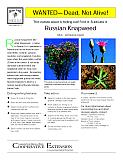Appendix H - Russian Knapweed Fact Sheet
Noxious Species: Russian Knapweed
Prevalent throughout Pershing County is Russian knapweed (Acroptilon repens), a state listed noxious weed. Together with other state-listed members of the same genera: Diffuse, Spotted and Squarrose knapweed; these weeds fall under the definition of noxious: “any species of plant which is, or is likely to be, detrimental or destructive and difficult to control or eradicate” by the Nevada Revised Statutes (NRS 555.005, Nevada Administrative Code 555.010). The provisions of the NRS and Nevada Administrative Code designate noxious weed control as the responsibility of every landowner or occupant. The law also provides for the establishment of weed districts, which have authority to control noxious weeds.
Within Pershing County, the Lovelock Valley Weed Control District is the only established district to date. The district has authority to control whitetop (Cardaria sp., Lepidium sp.), knapweed (Centaurea sp. and Acroptilon sp.), puncture vine (Tribulus sp.), and licorice (Glycyrrhiza sp.) within Lovelock Valley and along the Humboldt River below Rye Patch Reservoir. The County has also formed the Pershing County Cooperative Weed Management Area, which includes the land management agencies within the County. The Winnemucca BLM District has been spraying noxious weeds and is working with the County road department to increase the spraying coverage. The Nevada Department of Transportation treats the areas along state routes and highways for noxious weeds.
Russian knapweed was noted as occurring frequently at both high and low densities around Humboldt, Imlay, Lovelock, and Rye Patch. Though knapweed was not found in all communities, it is an invasive perennial plant that can spread rapidly if control measures are not enforced. Though not typically a high fuel hazard, Russian knapweed’s propensity to spread and form high-density patches highlights the responsibility of all landowners to work together to decrease the current rate of spread and density of the species. For more information about how private landowners can get involved in the control effort call Carl Clinger, Chairman of the Cooperative Weed Management Area at (775) 273-2552, or the Natural Resources Conservation Service at (775) 273-2134. Russian Knapweed Fact Sheet
Russian Knapweed info sheet
Download the Russian Knapweed info sheet for Pershing County

(PDF, 267kb, 2 pages)
